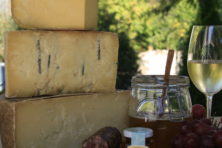The Cheese Insider
- Share
- Tweet
- Pin
- Share
In the late 1960s, the state and federal government made plans to dam a huge area of the flood-prone Kickapoo Valley in the beautiful un-glaciated area of southwest Wisconsin. The project would create a large recreational lake and eliminate flooding in the region.
During this same period, the Kickapoo Valley had become something of a magnet for spiritually minded, city people escaping the crowds for a simpler life. These settlers and many other residents of the area were against the government’s plan.
Opponents of the project succeeded, leaving the marginal dairy land of the valley to the Amish farmers and a group of traditional and hippie dairy farmers. These groups, which didn’t always play well with one another at the time, were united in their desire to see the land stay in its natural state.
To preserve the land, they needed to find ways to make marginal dairy land, and small herds, pay more than what they earned. The farmers were simply not competitive with large mega farms that were beginning to be built.
Organic Valley Cooperative was founded in La Farge in 1988 to make Coulee Region farmers more profitable and to make the world a better place for farming. The coop and others in the organic movement were looking for enough consumers who believed they and the world would benefit if they paid higher prices for milk that was certified “more beneficial.”
Today, Organic Valley Cooperative, the largest organic co-op in the world, with sales of nearly $1 billion, has more than 1,800 members in thirty states and four Canadian provinces. The company produces milk, yogurt, butter, ice cream and cheese in plants located throughout North America.
The company headquarters are still located in La Farge, Wisconsin and employs more than 400 people.
Shelf Life
At a “Meet the Cheesemaker” event held this summer at Savory Spoon Cooking School in Ellison Bay, the guest speaker, Dean Sommer, lead Cheese and Food Technologist at the Center for Dairy Research at the University of Wisconsin-Madison, was asked, “Why does Organic Valley milk have such a long shelf life?”
As a point of reference, regular milk that you buy in the grocery store has a shelf life of 21 days, while Organic Valley milk has a shelf life of about 60 days.
Regular, store-bought milk is normally pasteurized with what is known as HTST (high temperature/short time) method. This method takes milk and heats it to 161 degrees F for 15 seconds, then immediately cools the milk. This same method of pasteurization is used by most cheesemakers during the cheese making process.
Organic Valley uses what is known as UP (ultra pasteurization), also known as UHT (ultra high temperature) method. The milk is heated to 280 degrees F for 2 seconds, and then quickly cooled. This method gives milk three times the shelf life, but also creates a hint of a “burnt” flavor to the milk. Using this method of pasteurization also allows some of the Organic Valley milk products to be what is known as “shelf stable,” meaning they do not need to be refrigerated.
Wisconsin has become a leader in the production of organic dairy products, not only with Organic Valley, but with many other independent producers. Although you will always pay more for organic products, at least you now have more choices to choose from.
Sources: Creating Dairyland by Edward Janus; organicvalley.coop



